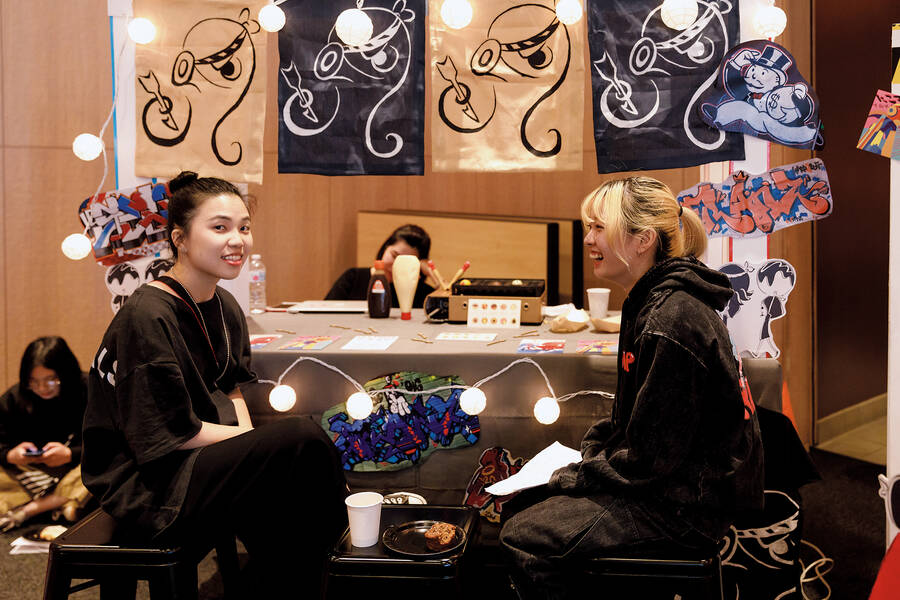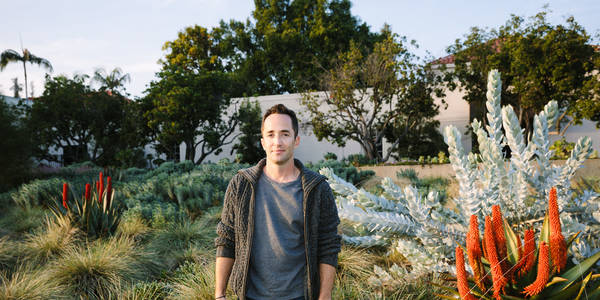feature / environmental-design / students / spring-2020
May 28, 2020
Writer: Mike Winder
Photographer: Juan Posada
REAL THING リアル シング
Pacific Rim: Undercover Street Culture unearths the authentic
It’s a crisp December morning at ArtCenter DTLA—the College’s new space in downtown Los Angeles—and students have just presented their final projects for the Environmental Design–led Transdisciplinary Studio course Pacific Rim: Undercover Street Culture. The lobby, with its early-20th-century charm and white-painted walls, generally looks pristine. Today, it looks like organized chaos. Mannequin torsos wearing Supreme T-shirts hang from the ceiling. A red octopus sculpture looms large over a food cart serving takoyaki, Japanese ball-shaped snacks. Graffiti-covered produce crates form a ramshackle DJ booth. Plush anime figures sit atop furniture. Moving English and Japanese phrases fly across semitransparent textiles.

About The Images
Students in Pacific Rim: Undercover Street Culture uncovered authentic cultural scenes in Los Angeles and created experiences for those scenes. The course final was held at the College’s new space in downtown L.A., ArtCenter DTLA.

Pacific Rim is an annual collaboration between ArtCenter and Tama Art University in Tokyo that stretches back to 2006. For each iteration of the course, Tama and ArtCenter students form teams and spend 14 weeks focusing on a specific topic, ranging from social issues (e.g., earthquake preparedness) to more ethereal cultural explorations (e.g., the use of light and shadow). Last year’s Tastemaking Tokyo took ArtCenter students to Japan to study the cultural, ritual and social aspects of dining. Next year’s Digital Ceramics will explore traditional Japanese craft via the latest 21st-century tools.
“What we’ve always tried to do with Pacific Rim projects is look at the richness of the cross-fertilization between Japan and California,” says David Mocarski, chair of ArtCenter’s graduate and undergraduate Environmental Design programs. “The course is about seeing how one culture influences another culture. It’s not just one direction. The fact that you can go to Tokyo and have a California roll is a good example of the back-and-forth that occurs.”
For Undercover Street Culture, the 14th Pacific Rim project, students were asked to uncover an authentic cultural scene in Los Angeles—be it food, music, fashion or street art—and to then create an experience catering to the needs of that scene. “When putting this project together, we wanted to offer something that would be compelling, provocative and relevant,” says Environmental Design Professor James Meraz to the assembled students, staff, faculty and guests. Meraz co-taught the course with his department colleague Associate Professor Yo Oshima. “The answer was to speculate about what’s next.”
Creating a music experience was the challenge taken on by student group One Eighty One. Their research highlighted that youth today are growing up with little tangible connection to their music. The death of record stores and the streaming services’ takeover of the industry mean music fans are longing for deeper interactions with both performers and one another, they say. To see how a concert can bring a community together, One Eighty One went to Leimert Park in South Los Angeles to attend Bananas, a monthly music showcase at neighborhood art space KAOS Network.
“When we got there, around 9 p.m., we were the only ones there, but eventually 15 people were up on stage, busting out rhymes,” says Pierre-Alain Auclair, an ArtCenter exchange student from Strate School of Design in Paris, France. “It felt like a family, and a space where everybody could go on stage, even if they weren’t good, and have fun. It felt like a place where real music was happening.”
For their project, One Eighty One designed a treasure-hunt-like experience for music fans interested in attending a mystery concert. Would-be concertgoers download an app to their phone that points them to a real-world location, such as a bar, where somebody—say, the bartender—then provides them with the first in a series of clues. Following the clues eventually leads to a pop-up venue (rapidly constructed from inexpensive materials like PVC pipes and wooden planks) located at an iconic yet unexpected location, such as the L.A. River.

“Music is not a typical subject in art school, so designing a music experience let me explore a lot of different possibilities,” says Jungwon Choi, a product design student at Tama, who’s originally from Seoul, South Korea. She appreciated the professors’ openness to experimentation, their honesty and their constructive feedback. “James and Yo wanted us to get creative and crazy, which was fun, and said we could always refine our ideas later,” she says. “At the final critique, they said, ‘This is good. This can be improved. Maybe next time you can think about this.’ That gave us possibilities.”
One of the trickiest parts of Undercover Street Culture is that the last thing a street scene connoisseur wants is for their favorite band, restaurant or store to be embraced by the mainstream. Today’s consumers—particularly members of younger generations—don’t want their decisions to feel preprogrammed. They want to feel as though they’ve arrived at their choices organically, and they want their dollars to support something authentic.
“It’s that old adage ‘I don’t want to belong to any club that would have me as a member,” says Mocarski, before adding that this year’s topic struck a nerve as it attracted more students than had previous Pacific Rim offerings. “This course is about outsider culture, stuff that doesn’t easily fit the mold. Whether the students were interested in anime or vinyl, they saw the class description and said, ‘That’s me!’”
For their project, student group Nise (Japanese for “bogus” or “sham”) created an experience that effectively flips upside-down the “drop”—a retail strategy that streetwear brands like Supreme, Anti Social Social Club and Off-White (but also larger entities like Nike, Gucci and Louis Vuitton) employ to create hype around the release, or “drop,” of limited-edition merchandise. In Nise’s project, consumers eager to purchase the latest merchandise first hunt down a Nise-branded ice-cream truck. Inside the truck, containers emblazoned with brand logos are handed out. Inside the containers, consumers find, yes, ice cream (in a subtle critique of the hype surrounding drop culture, all the containers are filled with chocolate, regardless of which brand logo they feature), but also a ticket for a forthcoming drop.

Once at the event, merch hunters find themselves at “Legal Trash,” a pop-up store with a line of mannequins stretching out the door. Inside, more mannequins—all decked out in logo-plastered T-shirts of the same brand—face the center of the room. In the center, stands a single mannequin, wearing a Nise T-shirt. A nearby manifesto reads, in part, “Nise exists to fuck with a stagnant, lame culture. A culture that chases after a bunch of bum-ass logos on a shirt. A culture that pressures millennials to spend their savings on overpriced garments.”
Finally, the customers end up in a room where they can purchase affordable “products” that turn everyday items into limited-edition merchandise: a Louis Vuitton logo roller to plaster any object with the fashion brand’s pattern; Off-White tags to affix to your current sneakers; and a Swoosh stencil to turn your current clothing into Nike apparel. “What’s so clever about this project is that the students are reading into the current social context,” says Pacific Rim co-instructor Oshima, who also teaches workshops and seminars at Tama. “Capitalism is encroaching into the world of street culture, which is supposed to be free and for everybody. It’s a criticism of that cultural aspect.”
For recent Film alumnus Joel Taylor (BFA 19), currently enrolled in an honorary ninth term at ArtCenter, Undercover Street Culture was an opportunity to explore subjects—streetwear and fashion—that he feels passionately about. “I’ve always been interested in urban life and how what we wear is a projection of a culture,” says New York City–raised Taylor, adding that his group spent a great deal of time conducting research to reverse-engineer the drop experience into something subversive. “We wanted to capture that early streetwear feeling, before the brand is commercialized or bought out by a larger corporate entity.”
Tama student and Tokyo native Nhi Dang enrolled in the course not only because of her interest in street culture, but also to test her communication skills. “At first, we didn’t know how to tackle the problems of real and fake, but by talking to the teachers we found the right words, and that helped strengthen the base of our project,” says Dang. “One of my aims for coming here was to make people from around the world understand what I’m trying to say through my design.”















